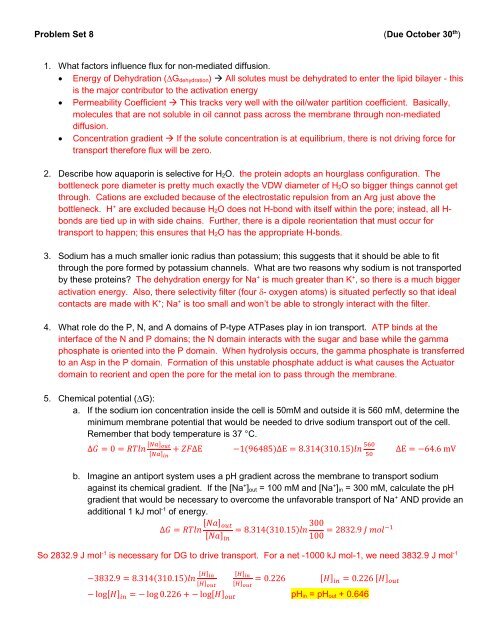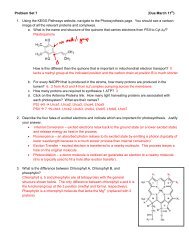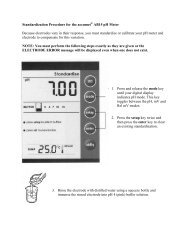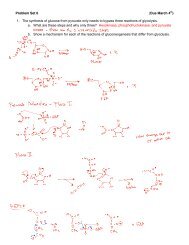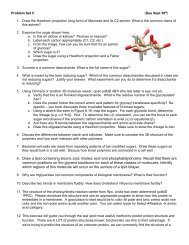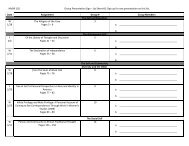Problem Set 8 Key
Problem Set 8 Key
Problem Set 8 Key
- No tags were found...
You also want an ePaper? Increase the reach of your titles
YUMPU automatically turns print PDFs into web optimized ePapers that Google loves.
<strong>Problem</strong> <strong>Set</strong> 8 (Due October 30 th )1. What factors influence flux for non-mediated diffusion.• Energy of Dehydration (∆G dehydration) All solutes must be dehydrated to enter the lipid bilayer - thisis the major contributor to the activation energy• Permeability Coefficient This tracks very well with the oil/water partition coefficient. Basically,molecules that are not soluble in oil cannot pass across the membrane through non-mediateddiffusion.• Concentration gradient If the solute concentration is at equilibrium, there is not driving force fortransport therefore flux will be zero.2. Describe how aquaporin is selective for H 2O. the protein adopts an hourglass configuration. Thebottleneck pore diameter is pretty much exactly the VDW diameter of H 2O so bigger things cannot getthrough. Cations are excluded because of the electrostatic repulsion from an Arg just above thebottleneck. H + are excluded because H 2O does not H-bond with itself within the pore; instead, all H-bonds are tied up in with side chains. Further, there is a dipole reorientation that must occur fortransport to happen; this ensures that H 2O has the appropriate H-bonds.3. Sodium has a much smaller ionic radius than potassium; this suggests that it should be able to fitthrough the pore formed by potassium channels. What are two reasons why sodium is not transportedby these proteins? The dehydration energy for Na + is much greater than K + , so there is a much biggeractivation energy. Also, there selectivity filter (four δ- oxygen atoms) is situated perfectly so that idealcontacts are made with K + ; Na + is too small and won’t be able to strongly interact with the filter.4. What role do the P, N, and A domains of P-type ATPases play in ion transport. ATP binds at theinterface of the N and P domains; the N domain interacts with the sugar and base while the gammaphosphate is oriented into the P domain. When hydrolysis occurs, the gamma phosphate is transferredto an Asp in the P domain. Formation of this unstable phosphate adduct is what causes the Actuatordomain to reorient and open the pore for the metal ion to pass through the membrane.5. Chemical potential (∆G):a. If the sodium ion concentration inside the cell is 50mM and outside it is 560 mM, determine theminimum membrane potential that would be needed to drive sodium transport out of the cell.Remember that body temperature is 37 °C.ΔGG = 0 = RRRRRRRR [NNNN] oooooo+ ZZZZΔΕ −1(96485)ΔΕ = 8.314(310.15)llll 560ΔΕ = −64.6 mV[NNNN] iiii 50b. Imagine an antiport system uses a pH gradient across the membrane to transport sodiumagainst its chemical gradient. If the [Na + ] out = 100 mM and [Na + ] in = 300 mM, calculate the pHgradient that would be necessary to overcome the unfavorable transport of Na + AND provide anadditional 1 kJ mol -1 of energy.ΔGG = RRRRRRRR [NNNN] oooooo= 8.314(310.15)llll 300 = 2832.9 JJ mmmmmm−1[NNNN] iiii 100So 2832.9 J mol -1 is necessary for DG to drive transport. For a net -1000 kJ mol-1, we need 3832.9 J mol -1[HH] iiii−3832.9 = 8.314(310.15)llll [HH] iiii= 0.226 [HH][HH] oooooo [HH] iiii = 0.226 [HH] oooooooooooo− log[HH] iiii = − log 0.226 + − log[HH] oooooo pH in = pH out + 0.646
c. What other transport mechanism might be able to pump sodium against its chemical gradient?Itcan be coupled to an ATPase6. Regarding nerve impulsesa. How do ligand gated and voltage gated ion channels work together to facilitate nerve impulses?In your answer, think critically about what depolarization and hyperpolarization mean and whyeach occur. In neurons, there are two types of gated ion channels; ligand and voltage. Theligand gated sodium channel responds to an extracellular signal and initiates a nerve impulse.The voltage gated ion channels then respond to the change in membrane potential due to theinflux of sodium; the voltage gated sodium channels bring more sodium into the nerve while thevoltage gated potassium channels move potassium out of the cell. The rapid increase inintracellular sodium is what depolarizes the cell (the membrane potential become much lessnegative, in fact, it becomes quite positive) while the export of potassium, a much slowerprocess, causes the hyperpolarization (the inside of the cell becomes much more negative andmakes the membrane potential more negative).b. Clearly describe what affect valinomycin, a K + ionophore, would have on nerve impulses.Ionophores facilitate transport of ions across a membrane down the concentration gradient in atransport-protein independent manner. The K + gradient would be destroyed if valinomycin cameinto contact with neurons and, as such, the net driving force for ion transport would be 0.7. You isolate a new strain of bacteria that has evolved to rely heavily on leucine and ethylene glycol forenergy. Of course, these molecules need to get inside the cell to be useful. One of these moleculesenter in a mediated fashion and the other through passive diffusion.a. Based on the experimental data below, determine which is which.b. For the passive diffuser, determine the permeability coefficient. Assume that [A] in is equal for alltrials.c. For the mediated diffuser, determine K t and J max.Leucine - MediatedEthylene glycol – Non-mediatedConcentration (µM)Initial Uptake RateConcentration Initial Uptake(µM s -1 )(mM)Rate (mM s -1 )1 110 0.5 502 220 1 1105 480 5 22010 830 10 48030 1700 50 830100 2600 100 1709.8500 31001000 3200
Kt = 28.4 µM Jmax = 3295.6 µM s -1Slope = permeability coeff = 15.51 s -18. GPCR:a. Clearly describe how GPCRs work. In your description, make sure to comment on the differenttypes of alpha subunits (i.e. G s, G i, G q) and any structural changes that are important forfunction. An extracellular signal is received by the GPCR. This triggers the movement of anintracellular helix that displaces the heterotrimeric G Protein, which is GDP bound at this time.GTP comes in and replaces the GDP triggering the dissociation of the α subunit (the actual Gprotein) from the β/γ. GTP-bound Gα interacts with Adenylate Cyclase. If this is a Gα,s, thenthe AC is stimulated and cAMP is produces. If this is a Gα,i, then cAMP production is inhibited.GTP hydrolysis (a slow process) results in three ‘switch’ regions to flip out and triggers Gα todissociate from the AC. In the case of the Gα,q, this protein interacts with and activatesphospholipase C (PLC). PLC hydrolyses PIP 3 to produce IP 3.b. Discuss the parallel role of PLC and AC in GPCR nucleated signal transduction cascades. PLCand AC are both activated in response to interacting with Gα and both produce secondarymessengers (cAMP and IP3, respectively). cAMP activated PKA and IP 3 ends up activatingPKC; these are both kinases that ‘mass phosphorylate’ enzymes in a regulatory manner.9. Calcium as a secondary messenger:a. Calcium is released by an IP3 gated Calcium Channel in the ER. Clearly explain what thismeans and why it is relevant. IP3 is only present when PLC is activated. IP3 binds to the IP3-gated ion channel and releases Calcium. Calcium serves as a secondary messenger thatactivates other kinases, including PKC.10. How is the insulin signal propagated to the nucleus? Please clearly articulate how the insulin receptorworks and how the signal is passed on to IRS-1. I don’t expect you to know the names of otherproteins involved, but be familiar with how the signal is propagated. Insulin binding triggersautophosphorylation of the PTK (protein tyrosine kinase) domain. Three Tyr get phosphorylated whichcauses a loop to flip out of the substrate binding groove and allows IRS-1 to bind. IRS-1 getphosphorylated which, in turn, activates the G Protein RAS (through Grb2-SOS). RAS then begins thekinase cascade which terminates with a phosphorylation-dependent transcription factor.


